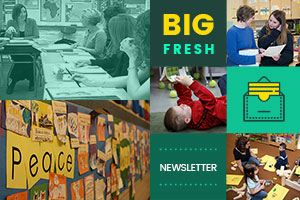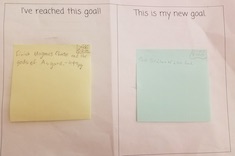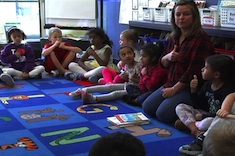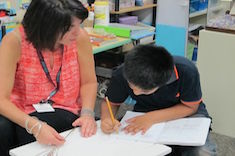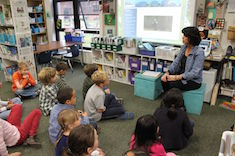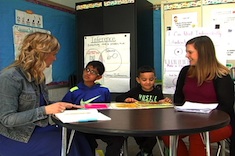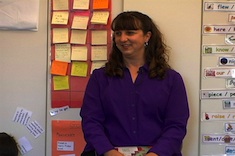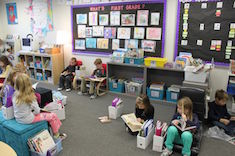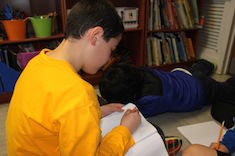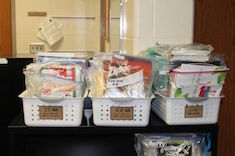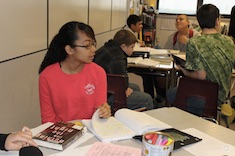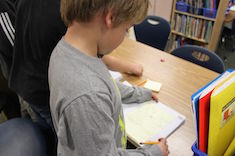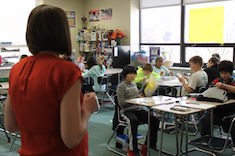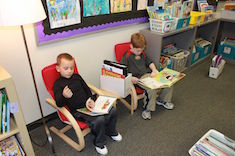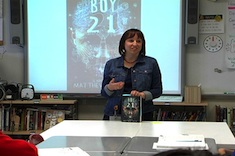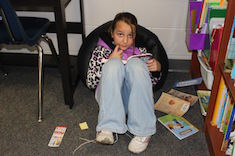Library
Choice Literacy Articles & Videos
The Choice Literacy library contains over 3,000 articles and 900 videos from 150+ contributors. Classic Classroom and Literacy Leadership subscribers have access to the entire library. Content is updated continuously, with five to six new features published each week.
Latest Content
Tracking Student Goals
Carly Ullmer transfers a messy goal-setting protocol to her seventh graders, and in the process finds they take on more accountability for individual success.
Minilesson: Measurable Reading Goals in Fourth Grade
Gigi McAllister has her fourth graders consider what makes a reading goal measurable.
The Big Fresh January 7, 2017 Lemonade Stand
Student self-assessment is the focus of this week’s Big Fresh. This is the first installment of a two-part newsletter series.
Conferring Questions
Ruth Ayres finds there can be a difference between questions in writing conferences that inspire an enthusiastic response, and those that foster more reflection and independence. Download a question list to use during your writing conferences.
Goal-Setting Ideas for Students
Melanie Meehan shares a wealth of ideas for better goal-setting with students.
Quick Reading Reflection in First Grade
Bitsy Parks has her first graders complete a quick reading reflection before a share session early in the school year.
Voice and Choice in the Goal-Setting Process
Clare Landrigan and Tammy Mulligan take a child step by step through the process of creating a meaningful writing goal.
Increasing Student Engagement During Minilessons
Melanie Meehan has tips for keeping students engaged during minilessons.
Mini-Breaks for Reading Engagement
Heather Fisher works with first graders to teach them the strategy of taking “mini-breaks” to sustain reading during workshops.
Celebrating Completed Books and Presenting New Ones
Gigi McAllister shares a quick daily routine of asking students to celebrate books they have finished reading before she introduces a new book to the class.
In Search of Just-Right Reading Spots
If children can choose just-right reading spots, they will have more stamina for reading. Heather Fisher explains how she works with first-grade teachers and students to build this skill.
Growing Writing Stamina
Tara Barnett and Kate Mills have a confession to make: in the first weeks of school, many of their fourth-grade students didn’t write much at all in workshops. It was only after tackling the issue of writing stamina head-on that they saw rapid progress.
Building Better Book Baggies
What happens when you establish a routine early in the year, only to discover students aren't using it a few months later? Shari Frost mentors a teacher who is helping his young students improve their book selection skills.
The Big Fresh December 17, 2016 Changing Our Focus
Audio and visual tools are the focus of this week’s Big Fresh.
Visual Essays
Gretchen Schroeder finds visual essays are a fun option for her high school students to present what they have learned just before Christmas break.
Getting Started with Voice Recorded Responses
Gigi MicAllister gives step-by-step advice on how she set up voice-recorded response as an option in her fourth-grade classroom.
Getting Started with Student Podcasting
If you’re interested in launching student podcasts, Matt Renwick has resources and tips for getting started.
Supporting Brave Writers
Tara Barnett and Kate Mills use the Sara Bareilles song “Brave” to help their fourth-grade students move from bed-to-bed stories to more emotive writing early in the year.
Everybody Wants to Be a Hero (and Needs a Guide)
We are wired for story, and sometimes children living hard lives need to learn how to rewrite their story. Ruth Ayres shares the teacher’s role in the process.
The Big Fresh December 10, 2016 Golf Course
Courage is the focus of this week’s Big Fresh.
The Big Fresh December 3, 2016 Tics
Revising writing is the focus of this week’s Big Fresh.
Teaching Students How to Give Revision Suggestions
Franki Sibberson shares a lesson progression to help students learn how to give helpful revision feedback. She uses online videos and resources to support her work.
Why I Don’t Like Erasers
Melanie Meehan explains why erasers can be problematic in writing workshops, beyond just eliminating the ability of teachers to see the progression of revisions in a young writer's work.
Story Maps for Reflection in the Midst of Drafting
Jennifer Allen finds the use of a story map opens up revision possibilities for a young writer stuck in a drafting rut.
Student (and Teacher) Risk-Taking
Carly Ullmer ponders what it means to take risks in her middle school classroom as she and her students experiment with different response options.
Partner Conference: Audiobooks to Support Comprehension
In this week's video, Gigi McAllister meets with two fourth graders who are reading the book Paper Things, talking about how using an audiobook can support comprehension.
The Big Fresh November 26, 2016 Secret Handshake
Book love is the focus of this week’s Big Fresh.
Using Paired Texts with Beginning Readers
Shari Frost explains how teachers can use paired texts to help young readers build their skills, starting with books they already know and love.
Book Talk: Boy21
Christy Rush-Levine piques interest in Boy21 through a book talk to her middle school students.
Creating a Culture of Book Love
Tara Smith shares some of her favorite online resources for keeping up with new books, as well as organizing tips for classroom libraries.
Browse Content By
Type
Category
- Assessment Tools
- Big Fresh Archives
- Booklists
- Choice Numeracy
- Classroom Design
- Common Core
- Community Building
- Conferring
- Content Literacy
- Digital Literacy
- English Language Learners
- Equity
- Family Relations
- Free Samples
- Guiding Groups
- Leadership
- Literacy Coaches
- Mentor Texts
- Minilessons
- New Teacher Mentors
- Podcasts
- Poetry
- Quote Collections
- Reading Strategies
- Self Care
- Struggling and Striving Learners
- Talking and Listening
- Teacher Study Groups
- Teaching Reading
- Teaching Writing
- Word Study and Vocabulary
Author
- Melissa Quimby
- Nawal Qarooni
- Gwen Blumberg
- Julie Cox
- The Lead Learners
- Hannah Tills
- Josie Stewart
- Ruth Metcalfe
- Mallory Messenger
- Becca Burk
- Jodie Bailey
- Vivian Chen
- Mary Brower
- Tiffany Abbott Fuller
- Stephanie Affinito
- Ruth Ayres
- Leigh Anne Eck
- Heather Fisher
- Shari Frost
- Julie Johnson
- Suzy Kaback
- Gigi McAllister
- Shirl McPhillips
- Melanie Meehan
- Cathy Mere
- Debbie Miller
- Tara Barnett and Kate Mills
- Tammy Mulligan
- Dana Murphy
- Bitsy Parks
- David Pittman
- Brenda Power
- Heather Rader
- Matt Renwick
- Mandy Robek
- Christy Rush-Levine
- Gretchen Schroeder
- Jen Schwanke
- Brian Sepe
- Katherine Sokolowski
- Stella Villalba
- Jennifer Vincent
Grade Level
Choice Literacy Membership
Articles
Get full access to all Choice Literacy article content
Videos
Get full access to all Choice Literacy video content
Courses
Access Choice Literacy course curriculum and training



